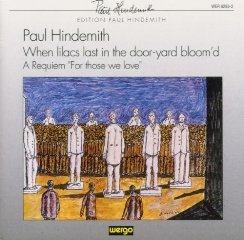Paul Hindemith – When Lilacs Last In The Door-yard Bloom'd - A Requiem 'For Those We Love' (1996)
Paul Hindemith – When Lilacs Last In The Door-yard Bloom'd - A Requiem 'For Those We Love' (1996)

1 Prelude For Orchestra 5:04 2 1. When Lilacs (Baritone And Chorus) 5:15 3 2. Arioso : In The Swamp (Mezzo-Soprano Solo) 2:55 4 3. March, Over The Breast Of The Spring (Chorus And Baritone) 6:59 5 4. O Western Orb (Baritone And Chorus) 2:19 6 5. Arioso : Sing On, There In The Swamp (Mezzo-Soprano Solo) 2:07 7 6. Song : O How Shall I Warble (Baritone And Chorus) 3:57 8 7. Introduction And Fugue : Lo! Body And Soul (Chorus) 5:08 9 8. Sing On! You Gray-Brown Bird (Mezzo-Soprano And Baritone, Soli And Duet) 9:45 10 9. Death Carol : Come, Lovely And Soothing Death (Chorus) 7:47 11 10. To The Tally Of My Soul (Baritone And Chorus) 6:52 12 11. Finale : Passing The Visions (Baritone And Mezzo-Soprano Soli And Chorus) 7:38 Baritone – Krister St Hill Chorus – Rundfunkchor Berlin Chorus Master – Dietrich Knothe Mezzo-soprano Vocals – Cornelia Kallisch Orchestra – Rundfunk-Sinfonieorchester Berlin Conductor – Lothar Zagrosek
Whitman's poem "When Lilacs Last in the Dooryard Bloom'd" was his elegy on the death of Abraham Lincoln. Hindemith's setting, subtitled "A Requiem for Those We Love," dates from 1946. It was conceived as a tribute to FDR and the Americans who fought and died in World War II and perhaps also as a lament for the destruction of German culture. The composer himself--whose music was banned by Hitler's regime thus forcing his emigration from Germany--had both public and private reasons for writing this piece, and the result is extremely moving and approachable. It's a true modern counterpart to Brahms's German Requiem. Robert Shaw commissioned the music and simply "owns" it. This is a definitive performance. ---David Hurwitz
Hindemith's setting of Whitman's When Lilacs Last in the Dooryard Bloom'd has been called his only "profoundly American" work. However, the double entendre of its original subtitle, "An American Requiem," alluding to Brahms's Ein deutsches Requiem, mirrors Hindemith's ambivalence about his own postwar cultural identity. Although the work's intertextual links with the German polyphonic tradition extend back to Bach, "Taps" is the only overt "American" reference. But the phrase in quotation marks within the final subtitle, "A Requiem 'For those we love,' " is the incipit of a World War I hymn of commemoration, "For those we love within the veil." Hindemith quotes verbatim the melody for this hymn from the 1940 Episcopal Hymnal, which identifies it as "Gaza," a "Traditional Jewish Melody" (in turn derived from a Yigdal). The Requiem may be reinterpreted as a covert commentary on Whitman's text from the post-Holocaust perspective of Hindemith's conflicted personal and artistic circumstances. ---Kim H. Kowalke, jstor.org
download (mp3 @320 kbs):
yandex mediafire ulozto gett bayfiles








